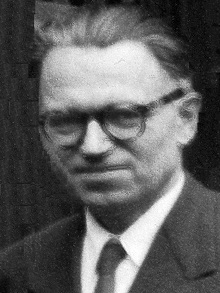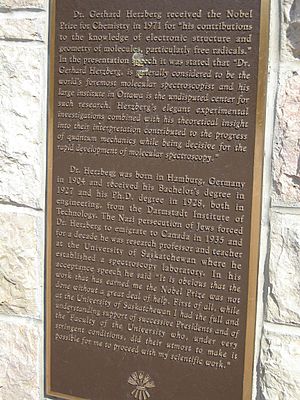Gerhard Herzberg facts for kids
Quick facts for kids
Gerhard Herzberg
|
|
|---|---|

Gerhard Herzberg, London 1952
|
|
| Born |
Gerhard Heinrich Friedrich Otto Julius Herzberg
December 25, 1904 |
| Died | March 3, 1999 (aged 94) |
| Nationality | German |
| Citizenship | Canadian |
| Alma mater | Technische Universität Darmstadt |
| Awards |
|
| Scientific career | |
| Fields | physical chemist |
| Institutions | Carleton University, National Research Council of Canada, University of Saskatchewan |
Gerhard Herzberg was a brilliant scientist from Germany who later became Canadian. He was a physicist and physical chemist. In 1971, he won the Nobel Prize for Chemistry. He earned this award for his amazing work on the "electronic structure and geometry of molecules." This means he studied how tiny particles called electrons are arranged in molecules, and what shapes these molecules have.
Herzberg was especially famous for studying "free radicals." These are very reactive molecules that are hard to study. He used a method called spectroscopy to figure out their secrets. Spectroscopy helps scientists understand what things are made of by looking at how they interact with light. Herzberg's work helped us understand molecules better, even those found in space! He also served as the head of Carleton University in Ottawa, Ontario, Canada, from 1973 to 1980.
Contents
Early Life and Family

Gerhard Herzberg was born in Hamburg, Germany, on December 25, 1904. His parents were Albin H. Herzberg and Ella Biber. He had an older brother named Walter. Gerhard started pre-school a little late because he got the measles.
His father passed away in 1914 when Gerhard was only nine years old. After his father's death, Gerhard finished pre-school. In 1929, he married Luise Oettinger. She was also a spectroscopist and worked with him on research. Luise Herzberg passed away in 1971.
Moving to Canada: Escaping the Nazis
In 1933, the Nazi Party in Germany made a new law. This law stopped men with Jewish wives from teaching at universities. Gerhard Herzberg was a lecturer at the university in Darmstadt. His wife, Luise, was Jewish. Because of this, they started planning to leave Germany in late 1933.
Leaving Germany was very difficult for many people trying to escape the Nazis. Luckily, Herzberg had worked with a visiting scientist named John Spinks from the University of Saskatchewan in Canada. Spinks helped Herzberg get a job at the university in Saskatoon. When the Herzbergs left Germany in 1935, the Nazis only let them take a very small amount of money and their personal belongings.
Education and Career Highlights
Gerhard Herzberg first wanted to study astronomy. But he was told he would need his own money to pursue that career. So, he decided to study physics and chemistry instead. He went to Darmstadt University of Technology with the help of a scholarship. He earned his Dr.-Ing. degree in 1928.
After his studies, Herzberg worked at several famous universities. He did research at the University of Göttingen and University of Bristol. In 1930, he became a lecturer at Darmstadt University of Technology.
Here are some of his important career steps:
- 1935: He became a guest professor at the University of Saskatchewan in Canada.
- 1936-1945: He worked as a Professor of Physics at the University of Saskatchewan.
- 1945-1948: He was a professor at the Yerkes Observatory at the University of Chicago in the United States.
- 1948: He became the Director of the Division of Pure Physics at the National Research Council of Canada. This was a very important role.
- 1951: He became a Fellow of the Royal Society of London, a major scientific honor.
- 1971: He won the Nobel Prize in Chemistry for his work on molecules.
- 1973-1980: He served as the Chancellor of Carleton University in Ottawa, Canada.
- 1999: Gerhard Herzberg passed away at the age of 94.
Awards and Honors
Gerhard Herzberg received many awards during his life. His biggest achievement was winning the 1971 Nobel Prize in Chemistry. The Nobel committee praised him for his work on the "electronic structure and geometry of molecules, particularly free radicals." At the time, many people considered him the world's best molecular spectroscopist.
Many scientific groups honored him with memberships and awards. Canada's top research award, the NSERC Gerhard Herzberg Canada Gold Medal for Science and Engineering, is named after him. This award started in 2000. The Canadian Association of Physicists also has an annual award in his honor.
The Herzberg Institute of Astrophysics, which studies space, is named after him. Even an asteroid, 3316 Herzberg, carries his name! At Carleton University, where he was Chancellor, a building for the Physics and Mathematics departments is called the Herzberg Laboratories. There is also a public park in Saskatoon named after him.
Books and Publications
Herzberg wrote several important books about spectroscopy. One famous book is Atomic Spectra and Atomic Structure. He also wrote a huge four-volume series called Molecular Spectra and Molecular Structure. Scientists often call this series the "spectroscopist's bible" because it's so important.
These books are still used today by scientists who study molecules and light. They contain a lot of information about how molecules behave and what they are made of.
- Atomic Spectra and Atomic Structure. (Dover Books, New York, 2010)
- The spectra and structures of simple free radicals: An introduction to molecular spectroscopy. (Dover Books, New York, 1971)
- Molecular Spectra and Molecular Structure: I. Spectra of Diatomic Molecules. (Krieger, 1989)
- Molecular Spectra and Molecular Structure: II. Infrared and Raman Spectra of Polyatomic Molecules. (Krieger, 1989)
- Molecular Spectra and Molecular Structure: III. Electronic Spectra and Electronic Structure of Polyatomic Molecules. (Krieger, 1989)
- Molecular Spectra and Molecular Structure IV. Constants of Diatomic Molecules, with K. P. Huber (Van nostrand Reinhold company, New York, 1979)
See also
 In Spanish: Gerhard Herzberg para niños
In Spanish: Gerhard Herzberg para niños
- Herzberg bands
- Collision-induced absorption and emission
- Methylene (compound)
- Pseudo Jahn–Teller effect
- Triatomic hydrogen
- Vibronic coupling
- List of German Canadians

